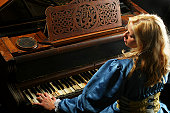
Good Hanon Exercises to Practice
The exercises are purely physical techniques that are designed primarily around how your hand moves rather than what notes are being played. As a result, it does not help much to develop the more musical techniques needed to be a good piano player. These exercises should be used to augment an existing piano training regime rather than as the only method of improving your abilities. Usually these techniques are used by more advanced players working toward virtuoso levels of ability rather than beginners or intermediate piano players. The first twenty Hanon exercises are intended to prepare piano players to play the later techniques. These techniques consist of fairly similar exercises that use different finger permutations to play the same basic exercise. This means that each exercise in the first twenty exercises is largely the same, but you play the notes in a different order. As a result, you have to work through and learn all twenty of these lessons before moving on to the later exercises. The reason is because each exercise builds upon the earlier ones. For example, the first exercise has the piano player play straight up the same line of notes in both hands. The second exercise has the same notes, but the order of two notes is swapped resulting in a slightly different exercise. The twentieth exercise has multiple different finger permutations and requires you to move across the keyboard as you play them. You need to build through the first twenty exercises before moving on.
Most of the exercises are more difficult applications of the skills developed in the first twenty exercises. However, a few of these exercises stand out and can be good to focus on. Exercise 34 and exercise 35 are focused around some more difficult thumb work used to shift your hand cleanly around the keyboard. Exercises 39 through 43 apply the same techniques used in the previous exercises to scales, modes and arpeggios. Unlike most of the exercises, these develop at least some muscle memory useful to actual playing. Exercises 44 through 60 are the most difficult exercises and targeted at some of the most difficult technical skills for a piano player. Ultimately, all of these exercises should be practiced with extra emphasis being given to any Hanon exercises that cover skills you have trouble with. For example, a student that has trouble with the trill technique should focus on exercise 46, which is a trill exercise. However, a student that has trouble with wrist techniques should focus on exercise 48, which is an exercise intended to be done solely with wrist playing. Anyone working on the Hanon exercises will get the most benefit by practicing all sixty exercises in order. In some cases, you can skip some exercises to focus on more useful ones. However, almost everyone needs to perfect the first twenty exercises to play the later ones. From that point, you can focus on exercises oriented towards issues you have with your piano technique and skipping some of the more straightforward ones.
=> http://pianoplayerworld.com/Hanon1.html
| ||||
|
Although every attempt has been made to make information as accurate as possible, we are not responsible for any errors that may appear.
 Hanon exercises are a series of sixty piano drills developed by
Hanon exercises are a series of sixty piano drills developed by 
 Exercises 21 through 43 are designed to develop virtuoso skill
further. These exercises are very difficult to play properly without mastering the first twenty Hanon
exercises. The exercises are similar to exercise 20, requiring multiple different finger permutations and
moving across the keyboard.
Exercises 21 through 43 are designed to develop virtuoso skill
further. These exercises are very difficult to play properly without mastering the first twenty Hanon
exercises. The exercises are similar to exercise 20, requiring multiple different finger permutations and
moving across the keyboard.



